Deciphering Common Genetic Pathways to Antibiotic Resistance in Escherichia coli Using a MEGA-Plate Evolution System
Abstract
1. Introduction
2. Results
2.1. Spatiotemporal Adaptation Dynamics
2.2. Variant Sampling and Sequencing
2.3. Construction of ARG Databases
2.4. Distribution and Clustering of ARGs
2.5. Resistance Mechanisms Identified
2.6. Single Nucleotide Polymorphisms (SNPs) and Mutations
2.7. Resistance to Disinfectants and Antiseptics
2.8. Phenotype of Resistant Strains
3. Comparative Analysis of Meropenem, Gentamicin, and Florfenicol Resistance Profiles
4. Functional Categorization of Antibiotic Resistance Genes
5. Discussion
5.1. Genomic Adaptations
5.2. Phenotype of Resistant Strains
5.3. Biological Functions
5.4. Study Limitations—Contextual Considerations
6. Materials and Methods
6.1. Microbial Strains and Conditions
6.2. Determination of Minimum Inhibitory Concentration (MIC)
6.3. Design of the 40 × 54 cm Acrylic MEGA-Plate
6.4. Sterilization of the MEGA-Plate and Culture Media
6.5. Inoculation of E. coli Bacteria and Selection of Resistant Phenotypes
6.6. DNA Extraction, Sequencing, and Bioinformatic Analysis
7. Conclusions
Supplementary Materials
Author Contributions
Funding
Institutional Review Board Statement
Informed Consent Statement
Data Availability Statement
Conflicts of Interest
References
- O’Neill, J. Tackling Drug-Resistant Infections Globally: Final Report and Recommendations; Wellcome Trust: London, UK, 2016. [Google Scholar]
- Palmer, A.C.; Kishony, R. Understanding, Predicting and Manipulating the Genotypic Evolution of Antibiotic Resistance. Nat. Rev. Genet. 2013, 14, 243–248. [Google Scholar] [CrossRef]
- Klein, E.Y.; Van Boeckel, T.P.; Martínez, E.M.; Pantalón; Suraj; Gandra, S.; Levin, S.A.; Goossens, H.; Laxminarayan, R. Global Increase and Geographic Convergence in Antibiotic Consumption between 2000 and 2015. Proc. Natl. Acad. Sci. USA 2018, 115, E3463–E3470. [Google Scholar] [CrossRef]
- Ventola, C.L. The Antibiotic Resistance Crisis: Part 1: Causes and Threats. Pharm. Ther. 2015, 40, 277. [Google Scholar]
- Baym, M.; Lieberman, T.D.; Kelsic, E.D.; Chait, R.; Gross, R.; Yelin, I.; Kishony, R. Spatiotemporal Microbial Evolution on Antibiotic Landscapes. Science 2016, 353, 1147–1151. [Google Scholar] [CrossRef]
- Lopatkin, A.J.; Meredith, H.R.; Srimani, J.K.; Pfeiffer, C.; Durrett, R.; You, L. Persistence and Reversal of Plasmid-Mediated Antibiotic Resistance. Nat. Commun. 2017, 8, 1689. [Google Scholar] [CrossRef]
- Andersson, D.I.; Hughes, D. Microbiological Effects of Sublethal Levels of Antibiotics. Nat. Rev. Microbiol. 2014, 12, 465–478. [Google Scholar] [CrossRef] [PubMed]
- Ching, C.; Zaman, M.H. Development and Selection of Low-Level Multi-Drug Resistance over an Extended Range of Sub-Inhibitory Ciprofloxacin Concentrations in Escherichia coli. Sci. Rep. 2020, 10, 8754. [Google Scholar] [CrossRef] [PubMed]
- Martinez, J.L.; Sánchez, M.B.; Martínez-Solano, L.; Hernandez, A.; Garmendia, L.; Fajardo, A.; Alvarez-Ortega, C. Functional Role of Bacterial Multidrug Efflux Pumps in Microbial Natural Ecosystems. FEMS Microbiol. Rev. 2009, 33, 430–449. [Google Scholar] [CrossRef]
- Neyfakh, A.A.; Bidnenko, V.E.; Chen, L.B. Efflux-Mediated Multidrug Resistance in Bacillus Subtilis: Similarities and Dissimilarities with the Mammalian System. Proc. Natl. Acad. Sci. USA 1991, 88, 4781–4785. [Google Scholar] [CrossRef]
- Sun, J.; Deng, Z.; Yan, A. Bacterial Multidrug Efflux Pumps: Mechanisms, Physiology and Pharmacological Exploitations. Biochem. Biophys. Res. Commun. 2014, 453, 254–267. [Google Scholar] [CrossRef]
- Elshamy, A.A.; Aboshanab, K.M. A Review on Bacterial Resistance to Carbapenems: Epidemiology, Detection and Treatment Options. Future Sci. OA 2020, 6, FSO438. [Google Scholar] [CrossRef] [PubMed]
- Nordmann, P.; Naas, T.; Poirel, L. Global Spread of Carbapenemase-Producing Enterobacteriaceae. Emerg. Infect. Dis. 2011, 17, 1791. [Google Scholar] [CrossRef]
- Durante-Mangoni, E.; Andini, R.; Zampino, R. Management of Carbapenem-Resistant Enterobacteriaceae Infections. Clin. Microbiol. Infect. 2019, 25, 943–950. [Google Scholar] [CrossRef]
- Meletis, G. Carbapenem Resistance: Overview of the Problem and Future Perspectives. Ther. Adv. Infect. Dis. 2016, 3, 15. [Google Scholar] [CrossRef]
- Baldwin, C.M.; Lyseng-Williamson, K.A.; Keam, S.J. Meropenem. Drugs 2008, 68, 803–838. [Google Scholar] [CrossRef]
- Steffens, N.A.; Zimmermann, E.S.; Nichelle, S.M.; Brucker, N. Meropenem Use and Therapeutic Drug Monitoring in Clinical Practice: A Literature Review. J. Clin. Pharm. Ther. 2021, 46, 610–621. [Google Scholar] [CrossRef]
- Tamma, P.D.; Aitken, S.L.; Bonomo, R.A.; Mathers, A.J.; van Duin, D.; Clancy, C.J. Infectious Diseases Society of America 2022 Guidance on the Treatment of Extended-Spectrum β-Lactamase Producing Enterobacterales (ESBL-E), Carbapenem-Resistant Enterobacterales (CRE), and Pseudomonas Aeruginosa with Difficult-to-Treat Resistance (DTR-P. Aeruginosa). Clin. Infect. Dis. Off. Publ. Infect. Dis. Soc. Am. 2022, 75, 187. [Google Scholar] [CrossRef]
- Krause, K.M.; Serio, A.W.; Kane, T.R.; Connolly, L.E. Aminoglycosides: An Overview. Cold Spring Harb. Perspect. Med. 2016, 6, a027029. [Google Scholar] [CrossRef] [PubMed]
- Phillips, I.; Eykyn, S.; King, B.A.; Jenkins, C.; Warren, C.A.; Shannon, K.P. The in Vitro Antibacterial Activity of Nine Aminoglycosides and Spectinomycin on Clinical Isolates of Common Gram-Negative Bacteria. J. Antimicrob. Chemother. 1977, 3, 403–410. [Google Scholar] [CrossRef]
- Beganovic, M.; Luther, M.K.; Rice, L.B.; Arias, C.A.; Rybak, M.J.; LaPlante, K.L. A Review of Combination Antimicrobial Therapy for Enterococcus Faecalis Bloodstream Infections and Infective Endocarditis. Clin. Infect. Dis. 2018, 67, 303–309. [Google Scholar] [CrossRef]
- Kohanski, M.A.; Dwyer, D.J.; Hayete, B.; Lawrence, C.A.; Collins, J.J. A Common Mechanism of Cellular Death Induced by Bactericidal Antibiotics. Cell 2007, 130, 797–810. [Google Scholar] [CrossRef] [PubMed]
- Ramirez, M.S.; Tolmasky, M.E. Aminoglycoside Modifying Enzymes. Drug Resist. Updat. Rev. Comment. Antimicrob. Anticancer Chemother. 2010, 13, 151. [Google Scholar] [CrossRef]
- Kerek, Á.; Török, B.; Laczkó, L.; Somogyi, Z.; Kardos, G.; Bányai, K.; Kaszab, E.; Bali, K.; Jerzsele, Á. In Vitro Microevolution and Co-Selection Assessment of Amoxicillin and Cefotaxime Impact on Escherichia coli Resistance Development. Antibiotics 2024, 13, 247. [Google Scholar] [CrossRef]
- Schwarz, S.; Kehrenberg, C.; Doublet, B.; Cloeckaert, A. Molecular Basis of Bacterial Resistance to Chloramphenicol and Florfenicol. FEMS Microbiol. Rev. 2004, 28, 519–542. [Google Scholar] [CrossRef]
- Tang, K.L.; Caffrey, N.P.; Nóbrega, D.B.; Cork, S.C.; Ronksley, P.E.; Barkema, H.W.; Polachek, A.J.; Ganshorn, H.; Sharma, N.; Kellner, J.D.; et al. Restricting the Use of Antibiotics in Food-Producing Animals and Its Associations with Antibiotic Resistance in Food-Producing Animals and Human Beings: A Systematic Review and Meta-Analysis. Lancet Planet. Health 2017, 1, e316. [Google Scholar] [CrossRef]
- Woolhouse, M.; Ward, M.; van Bunnik, B.; Farrar, J. Antimicrobial Resistance in Humans, Livestock and the Wider Environment. Philos. Trans. R. Soc. B Biol. Sci. 2015, 370, 20140083. [Google Scholar] [CrossRef]
- Lipsitch, M.; Samore, M.H. Antimicrobial Use and Antimicrobial Resistance: A Population Perspective. Emerg. Infect. Dis. 2002, 8, 347–354. [Google Scholar] [CrossRef]
- Blondeau, J.M. New Concepts in Antimicrobial Susceptibility Testing: The Mutant Prevention Concentration and Mutant Selection Window Approach. Vet. Dermatol. 2009, 20, 383–396. [Google Scholar] [CrossRef]
- Levin-Reisman, I.; Ronin, I.; Gefen, O.; Braniss, I.; Shoresh, N.; Balaban, N.Q. Antibiotic Tolerance Facilitates the Evolution of Resistance. Science 2017, 355, 826–830. [Google Scholar] [CrossRef] [PubMed]
- Nishino, K.; Inazumi, Y.; Yamaguchi, A. Global Analysis of Genes Regulated by EvgA of the Two-Component Regulatory System in Escherichia coli. J. Bacteriol. 2003, 185, 2667–2672. [Google Scholar] [CrossRef] [PubMed]
- Samantha, A.; Vrielink, A. Lipid A Phosphoethanolamine Transferase: Regulation, Structure and Immune Response. J. Mol. Biol. 2020, 432, 5184–5196. [Google Scholar] [CrossRef]
- Yerushalmi, H.; Schuldiner, S. An Essential Glutamyl Residue in EmrE, a Multidrug Antiporter from Escherichia coli*. J. Biol. Chem. 2000, 275, 5264–5269. [Google Scholar] [CrossRef] [PubMed]
- Hirakawa, H.; Takumi-Kobayashi, A.; Theisen, U.; Hirata, T.; Nishino, K.; Yamaguchi, A. AcrS/EnvR Represses Expression of the acrAB Multidrug Efflux Genes in Escherichia coli. J. Bacteriol. 2008, 190, 6276–6279. [Google Scholar] [CrossRef] [PubMed]
- Masuda, N.; Church, G.M. Escherichia coli Gene Expression Responsive to Levels of the Response Regulator EvgA. J. Bacteriol. 2002, 184, 6225. [Google Scholar] [CrossRef] [PubMed]
- Erol, I.; Jeong, K.-C.; Baumler, D.J.; Vykhodets, B.; Ho Choi, S.; Kaspar, C.W. H-NS Controls Metabolism and Stress Tolerance in Escherichia coli O157:H7 That Influence Mouse Passage. BMC Microbiol. 2006, 6, 72. [Google Scholar] [CrossRef]
- Nishino, K.; Yamaguchi, A. Role of Histone-Like Protein H-NS in Multidrug Resistance of Escherichia coli. J. Bacteriol. 2004, 186, 1423–1429. [Google Scholar] [CrossRef]
- Depardieu, F.; Bonora, M.G.; Reynolds, P.E.; Courvalin, P. The vanG Glycopeptide Resistance Operon from Enterococcus Faecalis Revisited. Mol. Microbiol. 2003, 50, 931–948. [Google Scholar] [CrossRef]
- Dorman, C.J. H-NS: A Universal Regulator for a Dynamic Genome. Nat. Rev. Microbiol. 2004, 2, 391–400. [Google Scholar] [CrossRef]
- Navarre, W.W.; Porwollik, S.; Wang, Y.; McClelland, M.; Rosen, H.; Libby, S.J.; Fang, F.C. Selective Silencing of Foreign DNA with Low GC Content by the H-NS Protein in Salmonella. Science 2006, 313, 236–238. [Google Scholar] [CrossRef]
- Garallah, E.T.; Al-Jubori, S.S. Molecular Detection of glpT and uhpT Genes as Fosfomycin Pathways in UTI Infection Patients. Gene Rep. 2020, 21, 100930. [Google Scholar] [CrossRef]
- Island, M.D.; Wei, B.Y.; Kadner, R.J. Structure and Function of the Uhp Genes for the Sugar Phosphate Transport System in Escherichia coli and Salmonella Typhimurium. J. Bacteriol. 1992, 174, 2754–2762. [Google Scholar] [CrossRef]
- Mowlaboccus, S.; Daley, D.A.; Birdsall, J.; Gottlieb, T.; Merlino, J.; Nimmo, G.R.; George, N.; Korman, T.; Streitberg, R.; Robson, J.; et al. Molecular Characterization of Fosfomycin-Resistant Escherichia coli Urinary Tract Infection Isolates from Australia. Clin. Microbiol. Infect. 2021, 27, 1360–1361. [Google Scholar] [CrossRef]
- Elkins, C.A.; Nikaido, H. Chimeric Analysis of AcrA Function Reveals the Importance of Its C-Terminal Domain in Its Interaction with the AcrB Multidrug Efflux Pump. J. Bacteriol. 2003, 185, 5349–5356. [Google Scholar] [CrossRef]
- Nishino, K.; Senda, Y.; Yamaguchi, A. CRP Regulator Modulates Multidrug Resistance of Escherichia coli by Repressing the mdtEF Multidrug Efflux Genes. J. Antibiot. 2008, 61, 120–127. [Google Scholar] [CrossRef]
- Ammar, A.M.; El-Naenaeey, E.-S.Y.; El-Malt, R.M.S.; El-Gedawy, A.A.; Khalifa, E.; Elnahriry, S.S.; El-Hamid, M.I.A. Prevalence, Antimicrobial Susceptibility, Virulence and Genotyping of Campylobacter Jejuni with a Special Reference to the Anti-Virulence Potential of Eugenol and Beta-Resorcylic Acid on Some Multi-Drug Resistant Isolates in Egypt. Animals 2020, 11, 3. [Google Scholar] [CrossRef] [PubMed]
- Blair, J.M.; Richmond, G.E.; Piddock, L.J. Multidrug Efflux Pumps in Gram-Negative Bacteria and Their Role in Antibiotic Resistance. Future Microbiol. 2014, 9, 1165–1177. [Google Scholar] [CrossRef] [PubMed]
- El-Sokkary, M.; Abdelmegeed, E. Characterisation of Class 1 Integron among Escherichia coli Isolated from Mansoura University Hospitals in Egypt. Adv. Microbiol. 2015, 5, 269–277. [Google Scholar] [CrossRef]
- Drusano, G. Meropenem: Laboratory and Clinical Data. Clin. Microbiol. Infect. 1997, 3, S51–S54. [Google Scholar] [CrossRef] [PubMed]
- Papp-Wallace, K.M.; Endimiani, A.; Taracila, M.A.; Bonomo, R.A. Carbapenems: Past, Present, and Future. Antimicrob. Agents Chemother. 2011, 55, 4943–4960. [Google Scholar] [CrossRef]
- Thomson, N.M.; Turner, A.K.; Yasir, M.; Bastkowski, S.; Lott, M.; Webber, M.A.; Charles, I.G. A Whole-Genome Assay Identifies Four Principal Gene Functions That Confer Tolerance of Meropenem Stress upon Escherichia coli. Front. Antibiot. 2022, 1, 957942. [Google Scholar] [CrossRef]
- Bos, J.; Zhang, Q.; Vyawahare, S.; Rogers, E.; Rosenberg, S.M.; Austin, R.H. Emergence of Antibiotic Resistance from Multinucleated Bacterial Filaments. Proc. Natl. Acad. Sci. USA 2015, 112, 178–183. [Google Scholar] [CrossRef]
- Cross, T.; Ransegnola, B.; Shin, J.-H.; Weaver, A.; Fauntleroy, K.; VanNieuwenhze, M.S.; Westblade, L.F.; Dörr, T. Spheroplast-Mediated Carbapenem Tolerance in Gram-Negative Pathogens. Antimicrob. Agents Chemother. 2019, 63, 9. [Google Scholar] [CrossRef] [PubMed]
- Lee, J.S.; Choi, J.-Y.; Chung, E.S.; Peck, K.R.; Ko, K.S. Variation in the Formation of Persister Cells against Meropenem in Klebsiella Pneumoniae Bacteremia and Analysis of Its Clinical Features. Diagn. Microbiol. Infect. Dis. 2019, 95, 114853. [Google Scholar] [CrossRef]
- Urbaniec, J.; Getino, M.; McEwan, T.B.-D.; Sanderson-Smith, M.L.; McFadden, J.; Hai, F.; La Ragione, R.; Hassan, M.M.; Hingley-Wilson, S. Anti-Persister Efficacy of Colistin and Meropenem against Uropathogenic Escherichia coli Is Dependent on Environmental Conditions. Microbiology 2023, 169, 001403. [Google Scholar] [CrossRef]
- Muhamad Hendri, N.A.; Nor Amdan, N.A.; Dounis, S.O.; Sulaiman Najib, N.; Louis, S.R. Ultrastructural and Morphological Studies on Variables Affecting Escherichia coli with Selected Commercial Antibiotics. Cell Surf. 2024, 11, 100120. [Google Scholar] [CrossRef] [PubMed]
- Alexander, J.; Hembach, N.; Schwartz, T. Identification of Critical Control Points for Antibiotic Resistance Discharge in Sewers. Sci. Total Environ. 2022, 820, 153186. [Google Scholar] [CrossRef] [PubMed]
- Hanafiah, A.; Sukri, A.; Yusoff, H.; Chan, C.S.; Hazrin-Chong, N.H.; Salleh, S.A.; Neoh, H. Insights into the Microbiome and Antibiotic Resistance Genes from Hospital Environmental Surfaces: A Prime Source of Antimicrobial Resistance. Antibiotics 2024, 13, 127. [Google Scholar] [CrossRef]
- Ma, X.; Dong, X.; Cai, J.; Fu, C.; Yang, J.; Liu, Y.; Zhang, Y.; Wan, T.; Lin, S.; Lou, Y.; et al. Metagenomic Analysis Reveals Changes in Bacterial Communities and Antibiotic Resistance Genes in an Eye Specialty Hospital and a General Hospital Before and After Wastewater Treatment. Front. Microbiol. 2022, 13, 848167. [Google Scholar] [CrossRef]
- Perry, M.R.; Lepper, H.C.; McNally, L.; Wee, B.A.; Munk, P.; Warr, A.; Moore, B.; Kalima, P.; Philip, C.; de Roda Husman, A.M.; et al. Secrets of the Hospital Underbelly: Patterns of Abundance of Antimicrobial Resistance Genes in Hospital Wastewater Vary by Specific Antimicrobial and Bacterial Family. Front. Microbiol. 2021, 12, 703560. [Google Scholar] [CrossRef]
- Wu, D.; Jin, L.; Xie, J.; Liu, H.; Zhao, J.; Ye, D.; Li, X. Inhalable Antibiotic Resistomes Emitted from Hospitals: Metagenomic Insights into Bacterial Hosts, Clinical Relevance, and Environmental Risks. Microbiome 2022, 10, 19. [Google Scholar] [CrossRef]
- Zhang, Z.; Zhang, Q.; Wang, T.; Xu, N.; Lu, T.; Hong, W.; Penuelas, J.; Gillings, M.; Wang, M.; Gao, W.; et al. Assessment of Global Health Risk of Antibiotic Resistance Genes. Nat. Commun. 2022, 13, 1553. [Google Scholar] [CrossRef]
- Gupta, S.; Arango-Argoty, G.; Zhang, L.; Pruden, A.; Vikesland, P. Identification of Discriminatory Antibiotic Resistance Genes among Environmental Resistomes Using Extremely Randomized Tree Algorithm. Microbiome 2019, 7, 123. [Google Scholar] [CrossRef] [PubMed]
- D’Costa, V.M.; McGrann, K.M.; Hughes, D.W.; Wright, G.D. Sampling the Antibiotic Resistome. Science 2006, 311, 374–377. [Google Scholar] [CrossRef] [PubMed]
- Kim, D.-W.; Cha, C.-J. Antibiotic Resistome from the One-Health Perspective: Understanding and Controlling Antimicrobial Resistance Transmission. Exp. Mol. Med. 2021, 53, 301–309. [Google Scholar] [CrossRef]
- Wright, G.D. The Antibiotic Resistome: The Nexus of Chemical and Genetic Diversity. Nat. Rev. Microbiol. 2007, 5, 175–186. [Google Scholar] [CrossRef]
- McEwen, S.A.; Collignon, P.J. Antimicrobial Resistance: A One Health Perspective. Microbiol. Spectr. 2018, 6, 521–547. [Google Scholar] [CrossRef] [PubMed]
- Robinson, T.P.; Bu, D.P.; Carrique-Mas, J.; Fèvre, E.M.; Gilbert, M.; Grace, D.; Hay, S.I.; Jiwakanon, J.; Kakkar, M.; Kariuki, S.; et al. Antibiotic Resistance Is the Quintessential One Health Issue. Trans. R. Soc. Trop. Med. Hyg. 2016, 110, 377. [Google Scholar] [CrossRef]
- Marshall, B.M.; Levy, S.B. Food Animals and Antimicrobials: Impacts on Human Health. Clin. Microbiol. Rev. 2011, 24, 718. [Google Scholar] [CrossRef]
- Baranova, N.; Nikaido, H. The baeSR Two-Component Regulatory System Activates Transcription of the yegMNOB (mdtABCD) Transporter Gene Cluster in Escherichia coli and Increases Its Resistance to Novobiocin and Deoxycholate. J. Bacteriol. 2002, 184, 4168–4176. [Google Scholar] [CrossRef]
- Nagakubo, S.; Nishino, K.; Hirata, T.; Yamaguchi, A. The Putative Response Regulator BaeR Stimulates Multidrug Resistance of Escherichia coli via a Novel Multidrug Exporter System, MdtABC. J. Bacteriol. 2002, 184, 4161–4167. [Google Scholar] [CrossRef]
- Nishino, K.; Honda, T.; Yamaguchi, A. Genome-Wide Analyses of Escherichia coli Gene Expression Responsive to the BaeSR Two-Component Regulatory System. J. Bacteriol. 2005, 187, 1763–1772. [Google Scholar] [CrossRef]
- Tramonti, A.; Visca, P.; De Canio, M.; Falconi, M.; De Biase, D. Functional Characterization and Regulation of gadX, a Gene Encoding an AraC/XylS-Like Transcriptional Activator of the Escherichia coli Glutamic Acid Decarboxylase System. J. Bacteriol. 2002, 184, 2603–2613. [Google Scholar] [CrossRef] [PubMed]
- Gallegos, M.T.; Schleif, R.; Bairoch, A.; Hofmann, K.; Ramos, J.L. Arac/XylS Family of Transcriptional Regulators. Microbiol. Mol. Biol. Rev. 1997, 61, 393–410. [Google Scholar] [CrossRef]
- Martin, R.G.; Rosner, J.L. The AraC Transcriptional Activators. Curr. Opin. Microbiol. 2001, 4, 132–137. [Google Scholar] [CrossRef]
- Ruiz, C.; Levy, S.B. Many Chromosomal Genes Modulate MarA-Mediated Multidrug Resistance in Escherichia coli. Antimicrob. Agents Chemother. 2010, 54, 2125–2134. [Google Scholar] [CrossRef]
- Schneiders, T.; Barbosa, T.M.; McMurry, L.M.; Levy, S.B. El Regulador Transcripcional MarA de Escherichia Coli Reprime Directamente La Transcripción de purA y hdeA*. J. Biol. Chem. 2004, 279, 9037–9042. [Google Scholar] [CrossRef] [PubMed]
- Andrews, J.M. Determination of Minimum Inhibitory Concentrations. J. Antimicrob. Chemother. 2001, 48 (Suppl. S1), 5–16. [Google Scholar] [CrossRef] [PubMed]
- Gullberg, E.; Cao, S.; Berg, O.G.; Ilbäck, C.; Sandegren, L.; Hughes, D.; Andersson, D.I. Selection of Resistant Bacteria at Very Low Antibiotic Concentrations. PLoS Pathog. 2011, 7, e1002158. [Google Scholar] [CrossRef]
- Macia, M.D.; Rojo-Molinero, E.; Oliver, A. Antimicrobial Susceptibility Testing in Biofilm-Growing Bacteria. Clin. Microbiol. Infect. 2014, 20, 981–990. [Google Scholar] [CrossRef]
- Olson, M.E.; Ceri, H.; Morck, D.W.; Buret, A.G.; Read, R.R. Biofilm Bacteria: Formation and Comparative Susceptibility to Antibiotics. Can. J. Vet. Res. 2002, 66, 86–92. [Google Scholar]
- Yu, G.; Baeder, D.Y.; Regoes, R.R.; Rolff, J. Predicting Drug Resistance Evolution: Insights from Antimicrobial Peptides and Antibiotics. Proc. R. Soc. B Biol. Sci. 2018, 285, 20172687. [Google Scholar] [CrossRef] [PubMed]
- Allen, R.C.; Popat, R.; Diggle, S.P.; Brown, S.P. Targeting Virulence: Can We Make Evolution-Proof Drugs? Nat. Rev. Microbiol. 2014, 12, 300–308. [Google Scholar] [CrossRef] [PubMed]
- Foster, K.R.; Bell, T. Competition, Not Cooperation, Dominates Interactions among Culturable Microbial Species. Curr. Biol. 2012, 22, 1845–1850. [Google Scholar] [CrossRef]
- Garza-Cervantes, J.A.; Meza-Bustillos, J.F.; Resendiz-Hernández, H.; Suárez-Cantú, I.A.; Ortega-Rivera, O.A.; Salinas, E.; Escárcega-González, C.E.; Morones-Ramírez, J.R. Re-Sensitizing Ampicillin and Kanamycin-Resistant, E. coli and S. sureus Using Synergistic Metal Micronutrients-Antibiotic Combinations. Front. Bioeng. Biotechnol. 2020, 8, 612. [Google Scholar] [CrossRef]
- M100 Ed34|Performance Standards for Antimicrobial Susceptibility Testing, 34th ed.; Clinical and Laboratory Standards Institute: Wayne, PA, USA, 2024; Available online: https://clsi.org/standards/products/microbiology/documents/m100/ (accessed on 11 November 2024).
- Wang, Y.; Zhao, Y.; Bollas, A.; Wang, Y.; Au, K.F. Nanopore Sequencing Technology, Bioinformatics and Applications. Nat. Biotechnol. 2021, 39, 1348–1365. [Google Scholar] [CrossRef]
- McArthur, A.G.; Waglechner, N.; Nizam, F.; Yan, A.; Azad, M.A.; Baylay, A.J.; Bhullar, K.; Canova, M.J.; De Pascale, G.; Ejim, L.; et al. The Comprehensive Antibiotic Resistance Database. Antimicrob. Agents Chemother. 2013, 57, 3348–3357. [Google Scholar] [CrossRef]
- Alcock, B.P.; Huynh, W.; Chalil, R.; Smith, K.W.; Raphenya, A.R.; Wlodarski, M.A.; Edalatmand, A.; Petkau, A.; Syed, S.A.; Tsang, K.K.; et al. CARD 2023: Expanded Curation, Support for Machine Learning and Resistome Prediction at the Comprehensive Antibiotic Resistance Database. Nucleic Acids Res. 2023, 51, D690–D699. [Google Scholar] [CrossRef]
- Alcock, B.P.; Raphenya, A.R.; Lau, T.T.Y.; Tsang, K.K.; Bouchard, M.; Edalatmand, A.; Huynh, W.; Nguyen, A.-L.V.; Cheng, A.A.; Liu, S.; et al. CARD 2020: Antibiotic Resistome Surveillance with the Comprehensive Antibiotic Resistance Database. Nucleic Acids Res. 2020, 48, D517–D525. [Google Scholar] [CrossRef]
- Jia, B.; Raphenya, A.R.; Alcock, B.; Waglechner, N.; Guo, P.; Tsang, K.K.; Lago, B.A.; Dave, B.M.; Pereira, S.; Sharma, A.N.; et al. CARD 2017: Expansion and Model-Centric Curation of the Comprehensive Antibiotic Resistance Database. Nucleic Acids Res. 2017, 45, D566–D573. [Google Scholar] [CrossRef]
- R: The R Project for Statistical Computing. Available online: https://www.r-project.org/ (accessed on 9 May 2024).
- Otasek, D.; Morris, J.H.; Bouças, J.; Pico, A.R.; Demchak, B. Cytoscape Automation: Empowering Workflow-Based Network Analysis. Genome Biol. 2019, 20, 185. [Google Scholar] [CrossRef] [PubMed]
- Bindea, G.; Mlecnik, B.; Hackl, H.; Charoentong, P.; Tosolini, M.; Kirilovsky, A.; Fridman, W.-H.; Pagès, F.; Trajanoski, Z.; Galon, J. ClueGO: A Cytoscape Plug-in to Decipher Functionally Grouped Gene Ontology and Pathway Annotation Networks. Bioinformatics 2009, 25, 1091–1093. [Google Scholar] [CrossRef] [PubMed]
- Jaccard, P. Étude comparative de la distribution florale dans une portion des Alpes et du Jura. Bull. Soc. Vaud. Sci. Nat. 1901, 37, 547–579. [Google Scholar] [CrossRef]
- Pheatmap Function in, R. R CHARTS|A Collection of Charts and Graphs Made with the R Programming Language. Available online: https://r-charts.com/correlation/pheatmap/ (accessed on 15 October 2024).
- Ggplot2 Package. R CHARTS|A Collection of Charts and Graphs Made with the R Programming Language. Available online: https://r-charts.com/ggplot2/ (accessed on 11 November 2024).
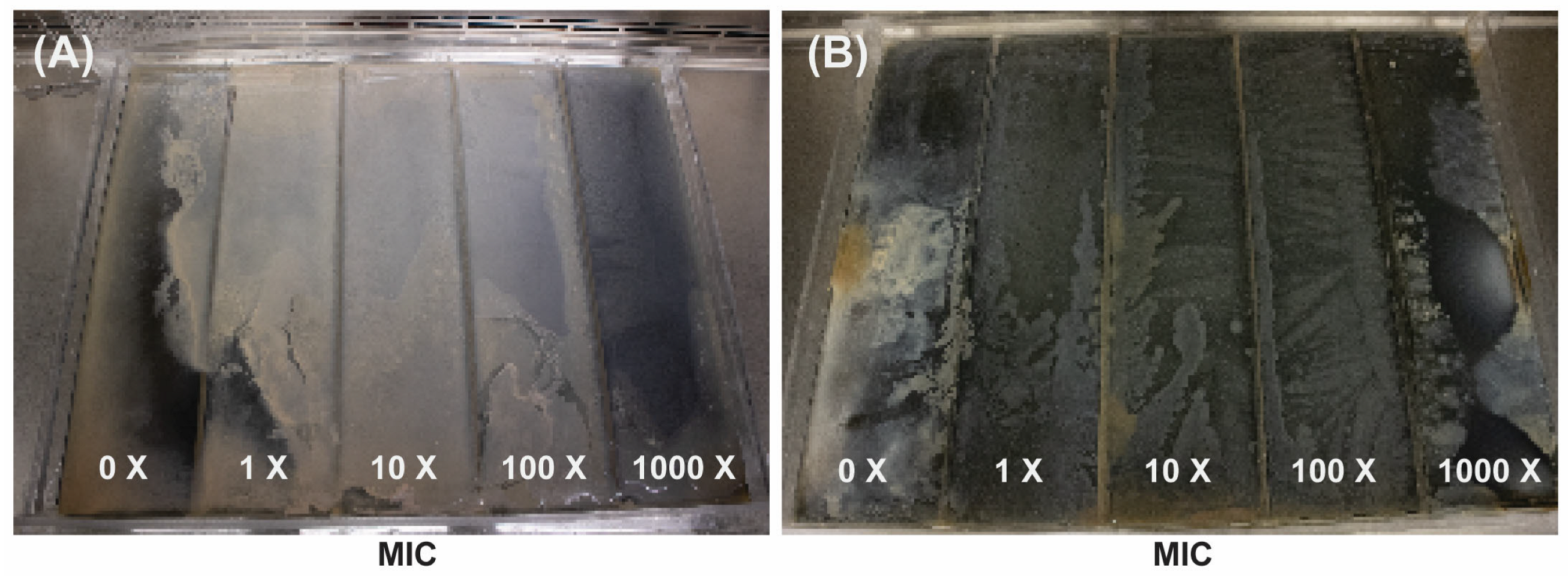
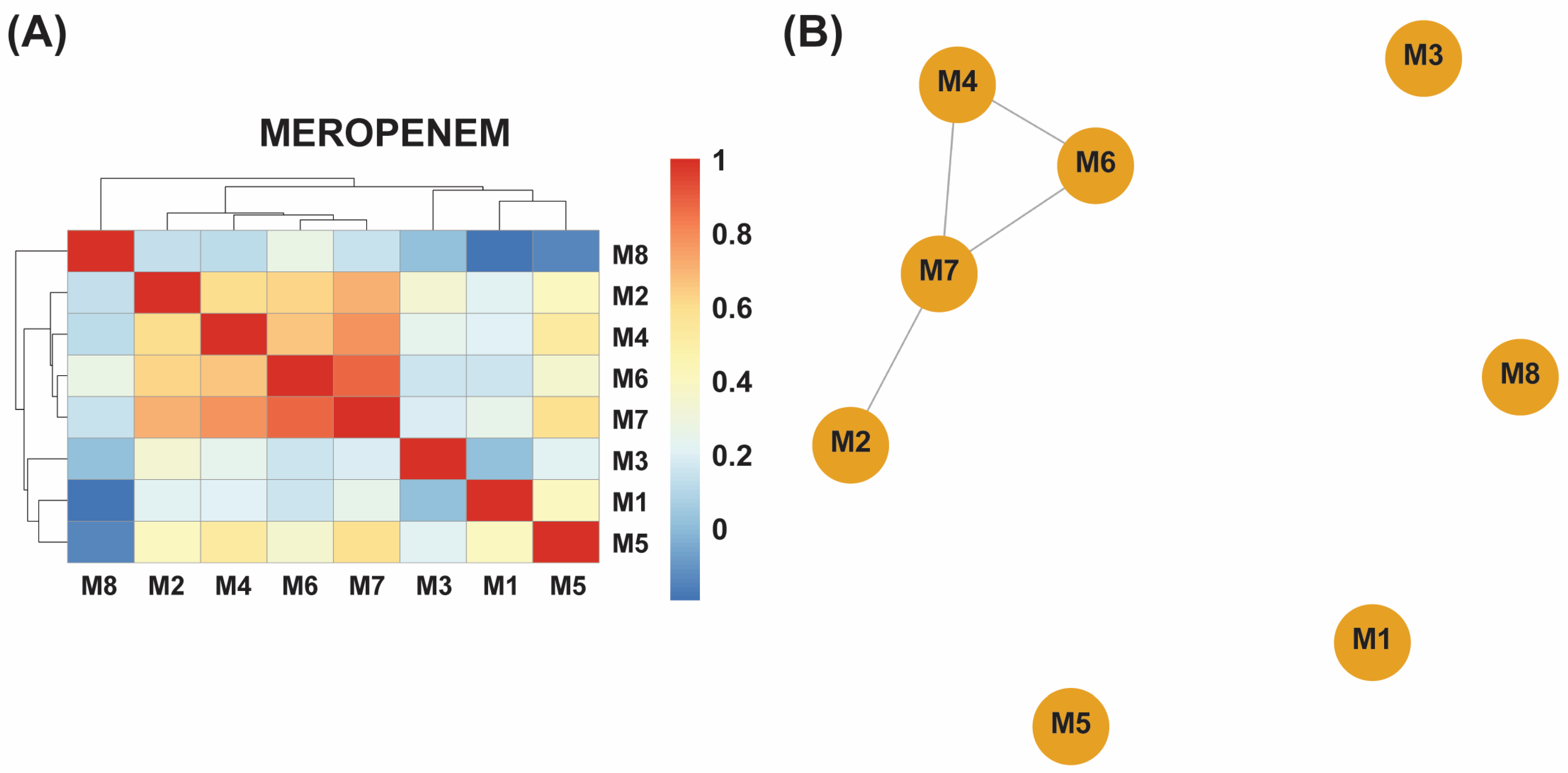
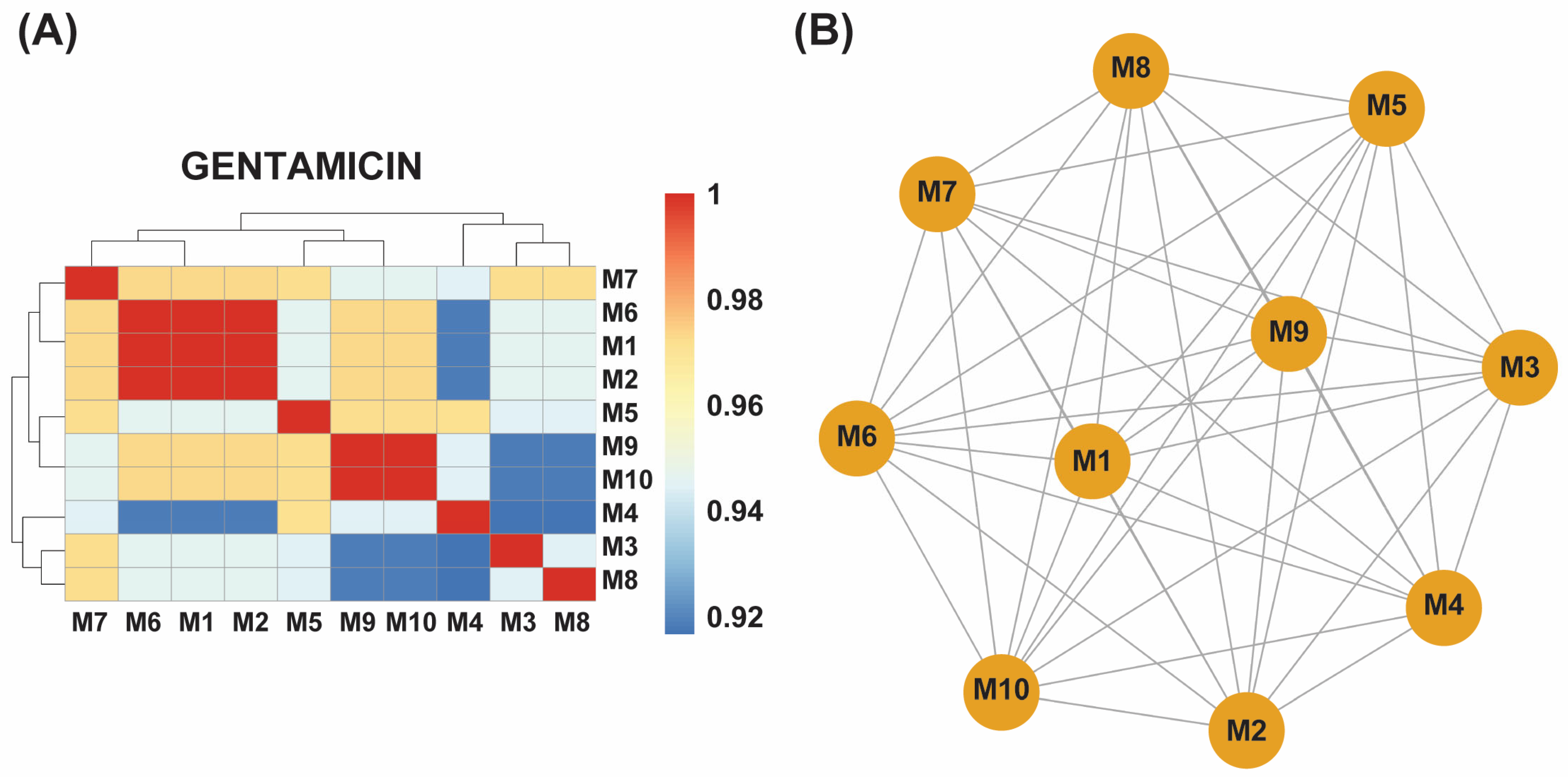
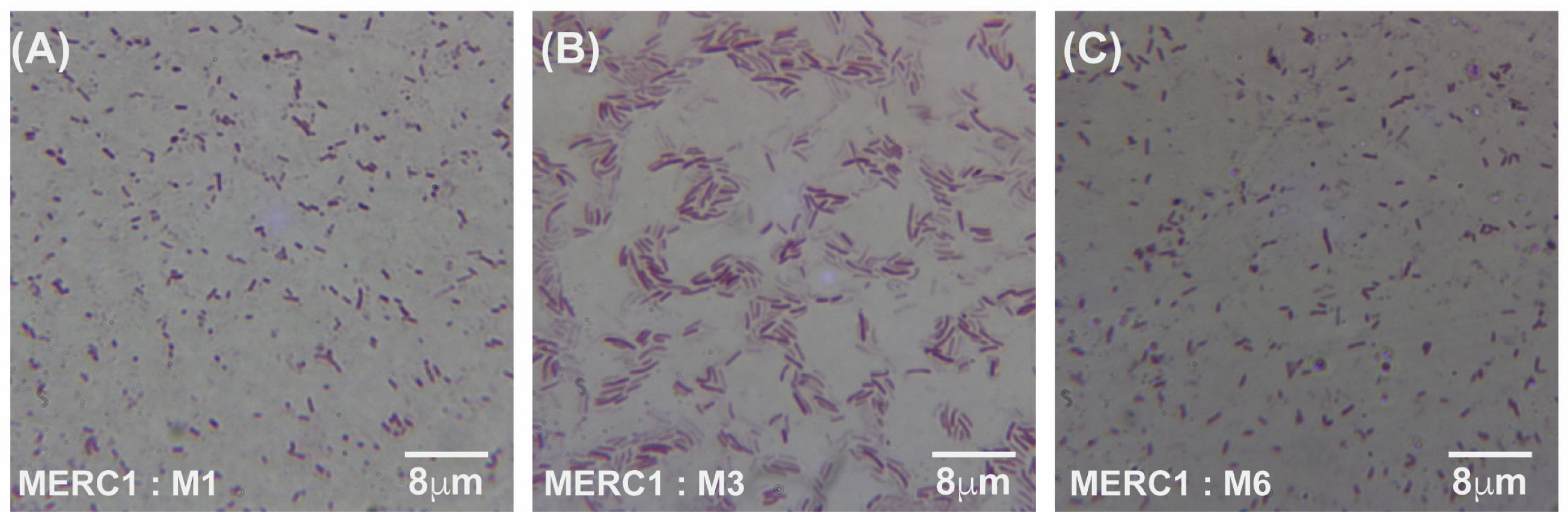
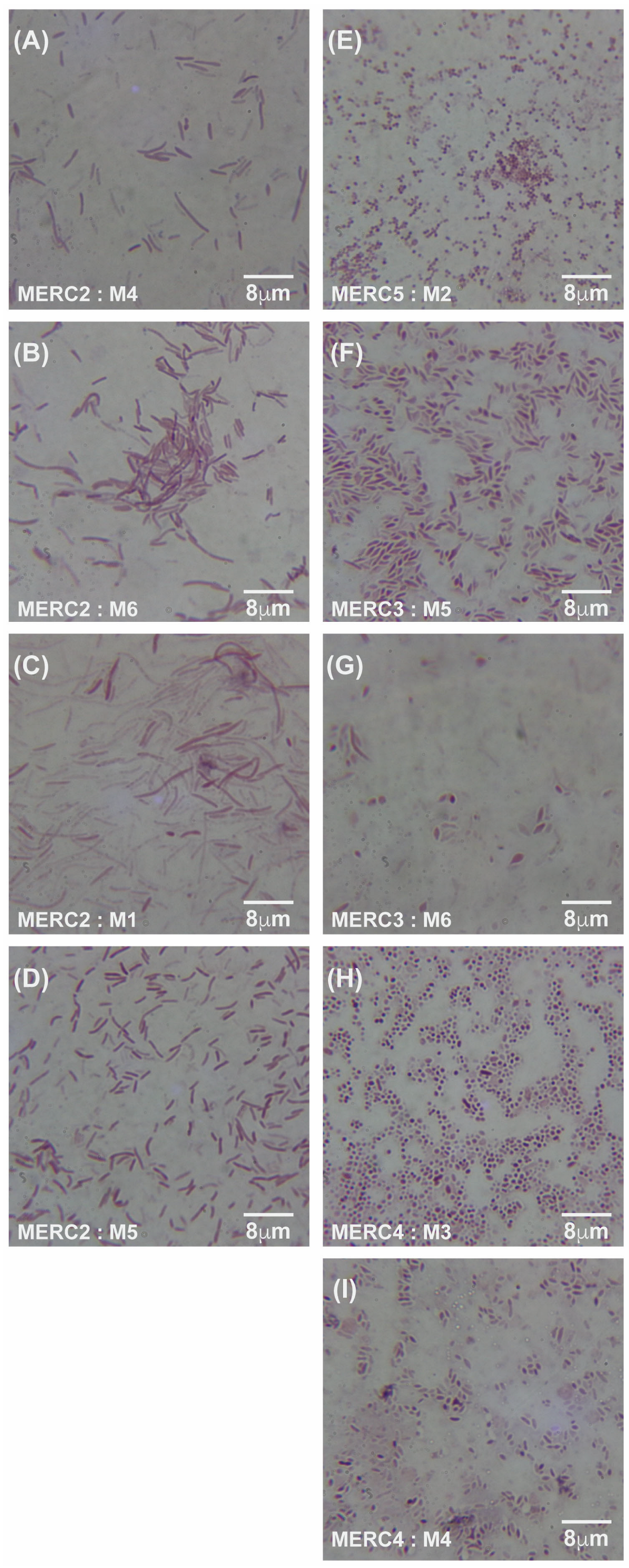
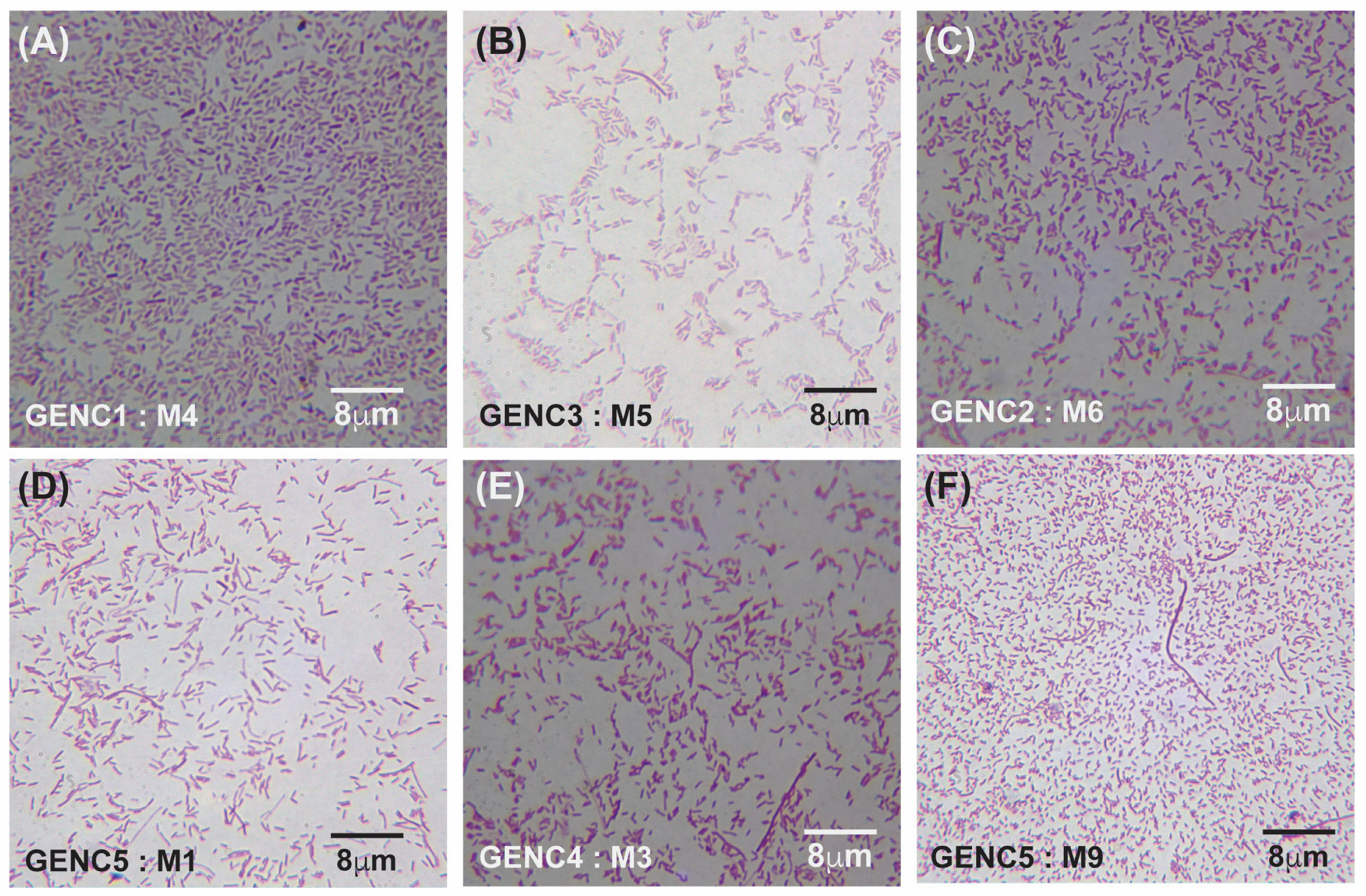
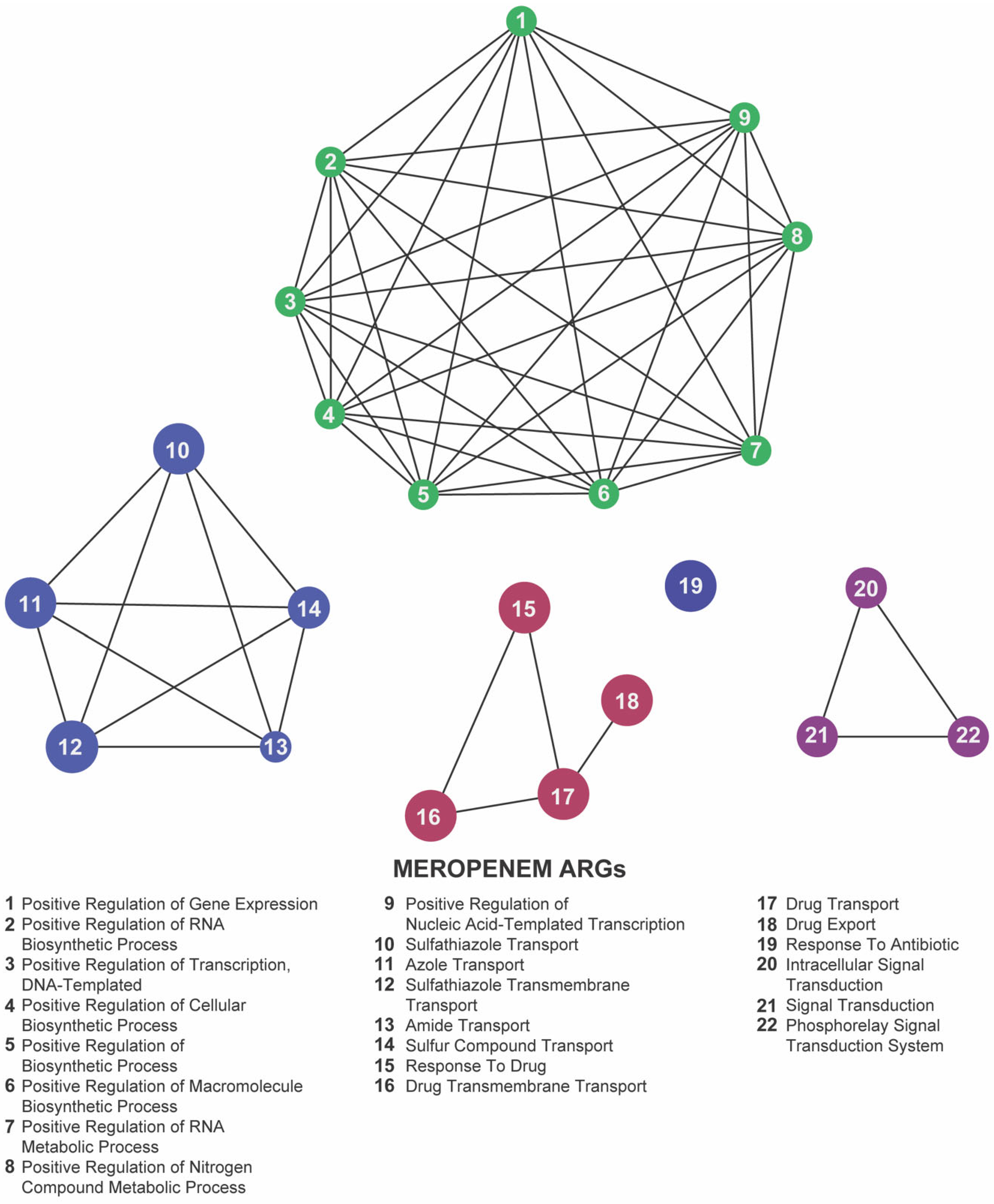
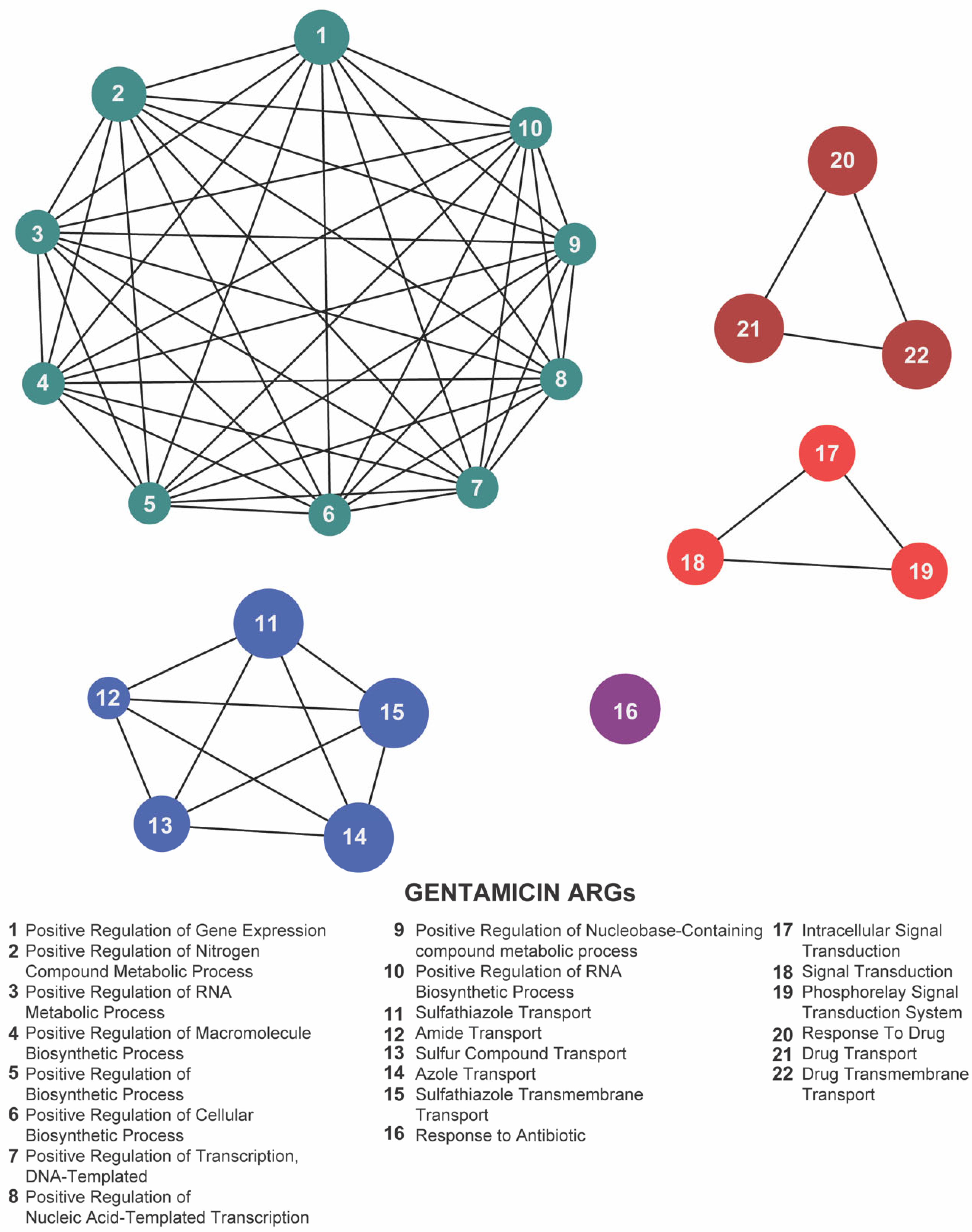
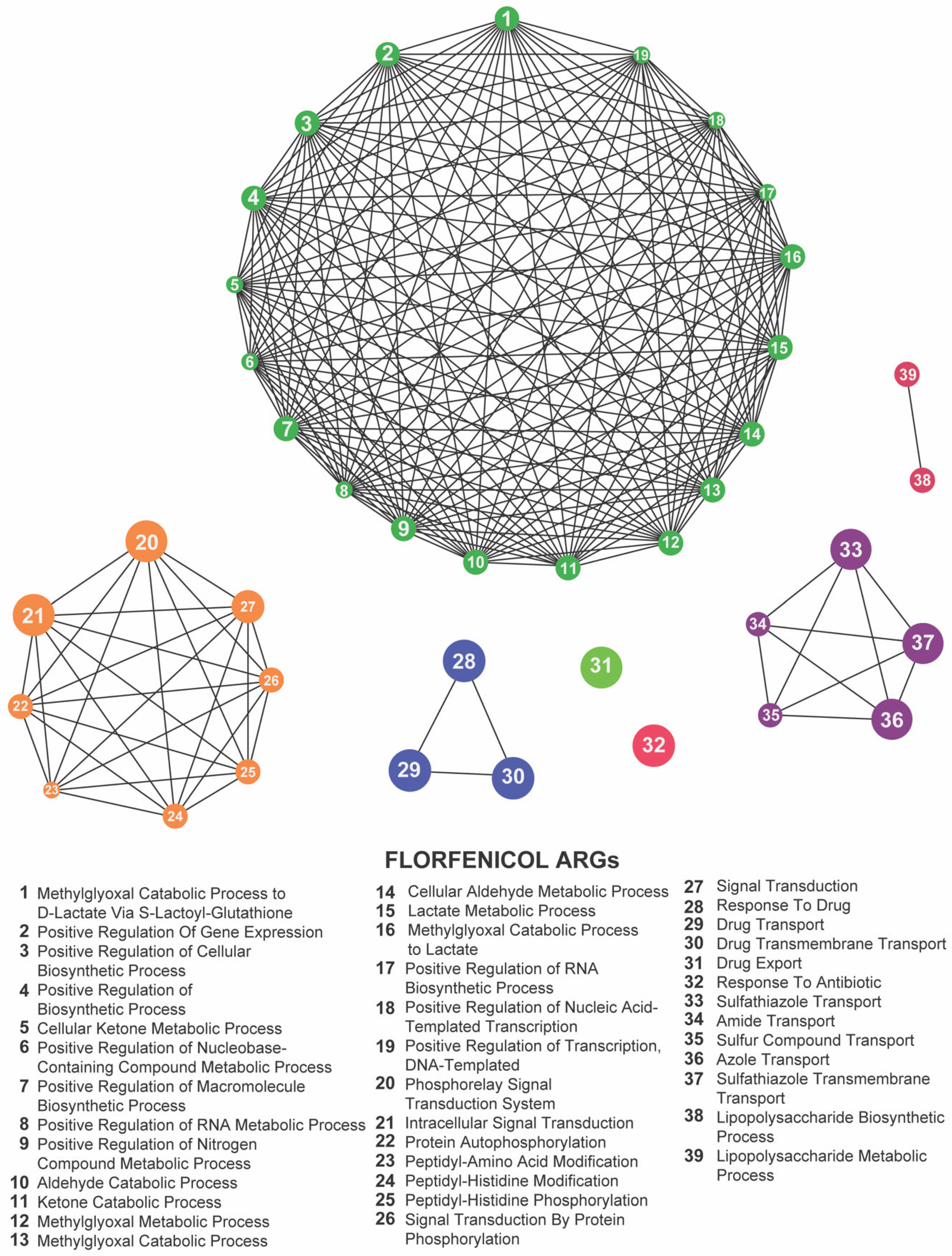
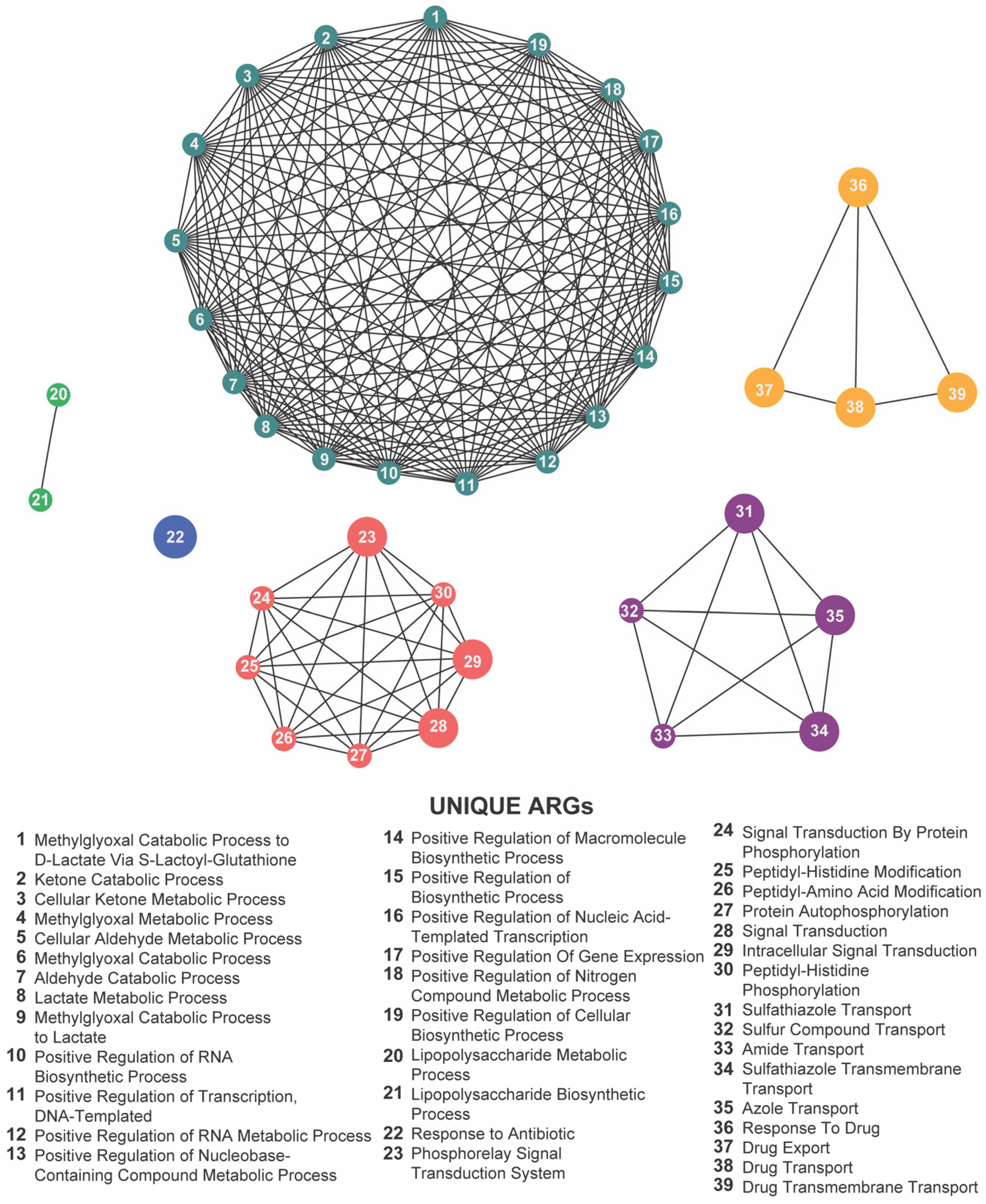
| Antibiotic | |||
|---|---|---|---|
| ARG | Florfenicol | Gentamicin | Meropenem |
| YojI | 1 | 0 | 1 |
| vanG | 0 | 1 | 1 |
| ugd | 1 | 0 | 0 |
| TolC | 1 | 0 | 1 |
| S. flexneri acrA | 0 | 1 | 0 |
| rsmA | 0 | 1 | 1 |
| qacJ | 0 | 1 | 1 |
| PmrF | 1 | 1 | 1 |
| msbA | 1 | 1 | 1 |
| mdtP | 1 | 1 | 1 |
| mdtO | 1 | 1 | 1 |
| mdtN | 1 | 1 | 1 |
| mdtM | 1 | 1 | 1 |
| mdtH | 1 | 0 | 1 |
| mdtG | 1 | 0 | 1 |
| mdtF | 1 | 1 | 1 |
| mdtE | 1 | 1 | 1 |
| mdtC | 1 | 0 | 1 |
| mdtB | 1 | 0 | 1 |
| mdtA | 1 | 0 | 1 |
| marA | 1 | 1 | 1 |
| leuO | 0 | 1 | 1 |
| kdpE | 1 | 0 | 1 |
| K. pneumoniae KpnE | 0 | 1 | 1 |
| K. pneumoniae KpnF | 0 | 1 | 1 |
| H. influenzae PBP3 | 0 | 1 | 1 |
| H-NS | 1 | 1 | 1 |
| gadX | 1 | 1 | 1 |
| gadW | 1 | 0 | 0 |
| evgS | 1 | 1 | 1 |
| evgA | 1 | 1 | 1 |
| eptA | 1 | 1 | 1 |
| emrY | 1 | 1 | 1 |
| emrR | 1 | 1 | 1 |
| emrK | 1 | 1 | 1 |
| emrB | 1 | 1 | 1 |
| emrA | 1 | 0 | 1 |
| EC-13 | 0 | 0 | 1 |
| E. coli soxS with mutation | 0 | 0 | 1 |
| E. coli soxR with mutation | 0 | 0 | 1 |
| E. coli mdfA | 1 | 0 | 1 |
| E. coli GlpT with mutation | 0 | 0 | 1 |
| E. coli emrE | 1 | 1 | 1 |
| E. coli EF-Tu mutants | 0 | 1 | 1 |
| E. coli ampH | 1 | 0 | 0 |
| E. coli ampC beta-lactamase | 1 | 0 | 1 |
| E. coli AcrAB-TolC with MarR mutations | 0 | 1 | 1 |
| E. coli AcrAB-TolC with AcrR mutation | 0 | 0 | 1 |
| E. coli acrA | 1 | 0 | 1 |
| E. coli UhpT with mutation | 0 | 1 | 1 |
| CRP | 1 | 1 | 1 |
| cpxA | 1 | 0 | 1 |
| baeS | 1 | 1 | 0 |
| baeR | 1 | 1 | 1 |
| bacA | 1 | 0 | 1 |
| ArnT | 0 | 1 | 1 |
| adeF | 0 | 1 | 1 |
| ACT-17 | 0 | 1 | 0 |
| AcrS | 1 | 1 | 1 |
| AcrF | 1 | 0 | 1 |
| AcrE | 1 | 0 | 1 |
| acrD | 1 | 0 | 1 |
| acrB | 1 | 0 | 1 |
Disclaimer/Publisher’s Note: The statements, opinions and data contained in all publications are solely those of the individual author(s) and contributor(s) and not of MDPI and/or the editor(s). MDPI and/or the editor(s) disclaim responsibility for any injury to people or property resulting from any ideas, methods, instructions or products referred to in the content. |
© 2025 by the authors. Licensee MDPI, Basel, Switzerland. This article is an open access article distributed under the terms and conditions of the Creative Commons Attribution (CC BY) license (https://creativecommons.org/licenses/by/4.0/).
Share and Cite
Morales-Durán, N.; León-Buitimea, A.; Álvarez Martínez, R.; Morones-Ramírez, J.R. Deciphering Common Genetic Pathways to Antibiotic Resistance in Escherichia coli Using a MEGA-Plate Evolution System. Antibiotics 2025, 14, 841. https://doi.org/10.3390/antibiotics14080841
Morales-Durán N, León-Buitimea A, Álvarez Martínez R, Morones-Ramírez JR. Deciphering Common Genetic Pathways to Antibiotic Resistance in Escherichia coli Using a MEGA-Plate Evolution System. Antibiotics. 2025; 14(8):841. https://doi.org/10.3390/antibiotics14080841
Chicago/Turabian StyleMorales-Durán, Nami, Angel León-Buitimea, Roberto Álvarez Martínez, and José Rubén Morones-Ramírez. 2025. "Deciphering Common Genetic Pathways to Antibiotic Resistance in Escherichia coli Using a MEGA-Plate Evolution System" Antibiotics 14, no. 8: 841. https://doi.org/10.3390/antibiotics14080841
APA StyleMorales-Durán, N., León-Buitimea, A., Álvarez Martínez, R., & Morones-Ramírez, J. R. (2025). Deciphering Common Genetic Pathways to Antibiotic Resistance in Escherichia coli Using a MEGA-Plate Evolution System. Antibiotics, 14(8), 841. https://doi.org/10.3390/antibiotics14080841








